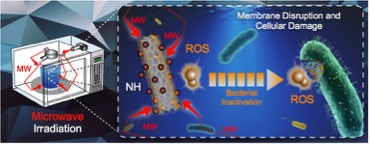
Research Project Full Title: Harnessing the Power of Microwave with Nanohybrids to Inactive Waterborne Pathogens
Principal Investigator(s): Drs. Navid B. Saleh, Lynn Katz (University of Texas), Tara Sabo-Attwood (University of Florida)
Researchers: Dr. Jaime Plazas-Tuttle, Dr. Dipesh Das, Craig Ayres (M.S. Student), Manjula Andukuri (undergraduate student)
Sponsor(s): National Science Foundation and U.S. Environmental Protection Agency
Full Abstract: Due to the position of microwave (MW) radiation in the electromagnetic spectrum, it has not yet been successfully utilized to inactivate waterborne microorganisms at a reasonable (energy) cost. Exceptional properties at the nano-scale, namely MW absorption-abilities of carbon nanotubes and excellent spectral conversion-capabilities of lanthanide series metal oxides in concert, hold promise to overcome the energetic barrier of this widely used and affordable technology. A nano-heterostructure has been synthesized that combines carbon nanotubes’ and erbium oxides’ properties to generate reactive oxygen species (ROS) and inactivate Pseudomonas aeruginosa. Detailed characterization of the synthesized nanohybrid (NH) material with electron microscopy, X-ray techniques, and thermal gravimetric analysis confirms effective hybridization. At least one log unit of microbial inactivation was achieved via ROS generation with only 20 s of MW irradiation at 110 W (0.0006 kW∙h energy use), using a conventional MW oven. Inactivation studies with ROS scavenger molecules prove that generated oxygen species played the dominant role in bacterial inactivation. These breakthrough results hold promise to enable an unintended use (i.e., disinfection) of MW technology, which is diffused deep into the global societal fabric.
This technology is currently being developed for inactivating pathogens (bacteria and viruses) relevant to drinking water and aquaculture (at the Food-Energy-Water nexus)
